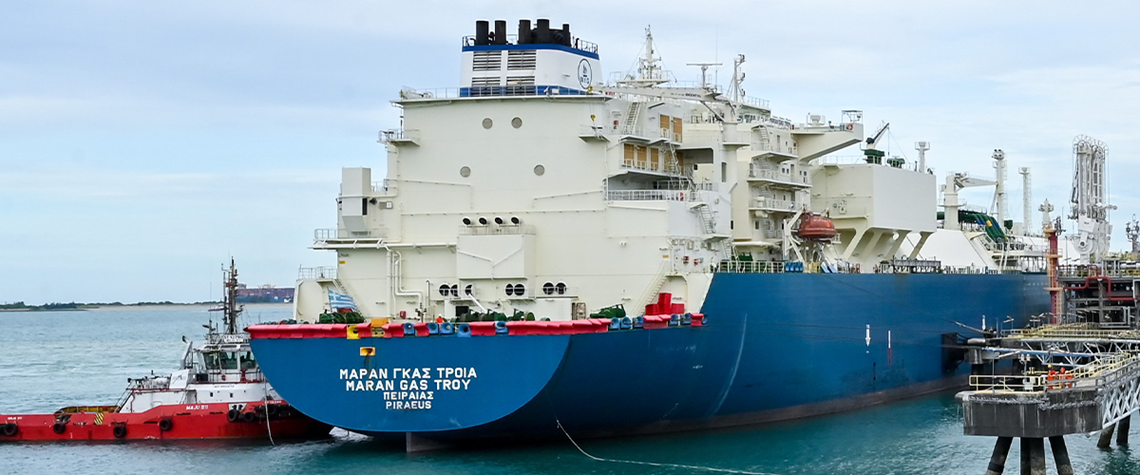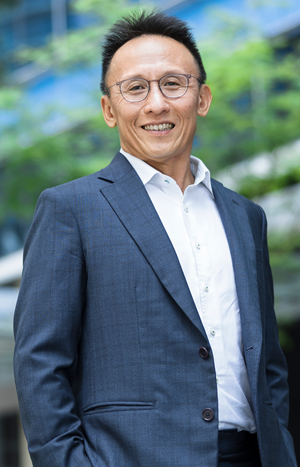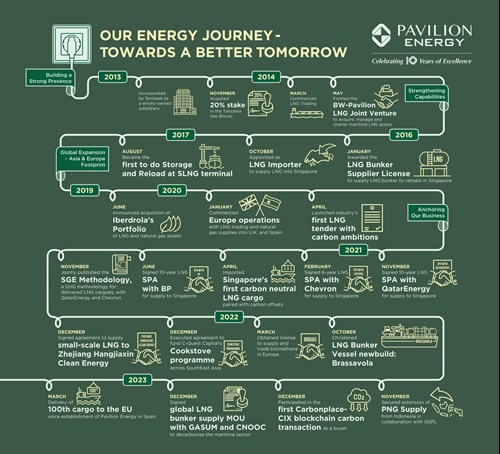The company continues to grow its LNG and natural gas portfolio to facilitate Asia’s transition away from coal and is formulating a strategy to become a supplier of future fuels such as ammonia and biomethane to customers in Asia-Pacific, Europe and beyond.
It may have looked like just another routine delivery, but the LNG carrier that docked at the Singapore LNG terminal on 16 May 2023—having travelled from Ras Laffan in Qatar—was carrying something special: Singapore’s first-ever statement of greenhouse gas emissions (SGE) for an LNG cargo.
For Singapore-based Pavilion Energy, the cargo’s buyer, it was the culmination of a process set in motion in 2020, when it launched a multi-year tender for LNG supply that required sellers to quantify the greenhouse gas (GHG) emissions associated with producing and delivering each cargo.
The question of how precisely that should be done was addressed the following year when—in co-operation with two of its LNG suppliers, QatarEnergy and Chevron—Pavilion Energy published the necessary SGE measurement, reporting and verification (MRV) methodology to drive greater transparency and stronger action on GHG reduction measures.
“Pavilion Energy was the first company to insist that suppliers provide a statement of GHG emissions with the delivered LNG cargo. We wanted our upstream suppliers to take responsibility in abating emissions along the value chain and that has encouraged other suppliers to do the same,” said Pavilion Energy’s Group CEO, Mr Alan Heng.
“It has generated a lot of conversations for the entire LNG industry and brought greater awareness and impetus to the whole discussion.”
That was certainly the case at the recent LNG 2023 conference in Vancouver, Canada, which brought together industry leaders and executives from around the world. One of the main topics of the presentations and discussions was the need to minimise the GHG emissions of LNG, because of the essential role it will need to play in the world’s transition to net-zero GHG emissions.
“We recognise that energy transition is a journey and that natural gas will continue to have an important role in helping economies to transition to a low-carbon future,” said Heng. “We advocate natural gas as a transition fuel of choice and continue to work to help the markets we operate in to tackle the ‘energy trilemma’ of security, affordability and sustainability.”
That trilemma was another key theme at LNG 2023 because of the recent turbulence of energy—and especially natural gas and LNG—markets.
Crisis and opportunity
The energy crisis of the past two years began in the second half of 2021 as demand surged after the Covid-19 pandemic and Russia began to reduce its pipeline gas exports to Europe. It was exacerbated by the impacts of Russia’s invasion of Ukraine in February 2022, after which its gas exports to Europe plummeted. A major consequence has been to sharpen awareness of the critical role that natural gas plays in the global energy system and the flexibility that LNG brings to supply.
Russia’s weaponisation of its pipeline gas supply to Europe led to a big reduction in global gas volumes, consequent price peaks that were previously unimaginable, and a fundamental reconfiguration of LNG flows as Europe sucked cargoes away from Asia—creating not just crisis but also opportunity, especially for an energy merchant company such as Pavilion Energy.
“We do not have any indigenous sources of gas in Singapore, so we are a price-taker,” said Heng. “If we have to import LNG at prices of $40-50/m Btu, that is a very expensive option.”
Fortunately, Singapore has a tradition of long-term and mid-term gas contracts, for example, for piped gas from Indonesia—generally indexed to crude oil—and so has been partially insulated from the crisis.
“Obviously, we have been paying higher prices for incremental demand and that has been an issue,” said Heng, “but the crisis has increased awareness that energy security is critical and that a diverse supply of piped gas and LNG, from different geographies, is important."
“As a company, it has sharpened our focus on risk management and the importance of supply reliability. We are significantly better at risk management and our middle office operations than we were back in 2021.”
Transformational transaction
Incorporated in 2013 as a wholly-owned subsidiary by Temasek—an investment company owned by Singapore’s government—Pavilion Energy is celebrating its tenth anniversary in 2023. Notable milestones during that decade are shown below.
One of Pavilion Energy’s first initiatives was to take a 20% stake in gas blocks in Tanzania in 2013, making it a partner in the country’s proposed LNG export project, which has recently made significant progress, putting it on track for start-up around 2030.
“We think it is a great opportunity,” said Heng. “It is going to be another production source that is not the US, not Qatar, and it sits beautifully in between the Atlantic and the Pacific basins.”
Today, Pavilion Energy has a natural gas and LNG portfolio equivalent to 8m t/yr and in fiscal year 2022/23 traded and delivered 6m t/yr of LNG. It has a fleet of six LNG carriers, of which three are owned by a Pavilion Energy/BW Group joint venture.
“We delivered one LNG cargo in 2014,” said Heng. “This year we will deliver 100.”
A pivotal moment in Pavilion Energy’s development came in mid-2019 when the company announced it was to acquire the LNG and natural gas assets of the Spanish energy company Iberdrola, a transaction which took effect from the start of 2020. That gave the company a foot in each of the two main LNG-consuming geographies—the Pacific Basin and the Atlantic Basin—and a physical presence in Spain, along with its existing operations in Singapore and Tanzania.
Pavilion Energy could not have foreseen what was to happen in Europe in 2022, of course—and the change that was to take place in the continent’s dependence on LNG—making its move into Spain more transformational than it could have hoped for at the time of the transaction.
The Iberdrola deal gave Pavilion Energy 4m t/yr of long-term sale and supply LNG contracts; long-term regasification capacity of 2m t/yr at the UK’s Isle of Grain import terminal; regasification capacity in Spain; pipeline capacity at the Spain/France border; and the time charter of a newbuild LNG vessel.
In a related transaction, Pavilion Energy agreed to supply gas to Iberdrola Generacion Espana, which carries out the group’s deregulated activities of electricity generation and electricity and natural gas retailing.
Today, Pavilion Energy accounts for 10% of the LNG imported into Spain; is one of Spain’s top five gas marketers; has gas licences in Spain, Italy, the UK, France and the Netherlands; and in March of this year delivered its 100th LNG cargo into Europe.
“When we entered the European market, the energy transition agenda was really full on,” said Heng. “At the time, some people even asked why we were doing that, given that Europe was then an incremental buyer of LNG because Russian supplies made up the bulk of its requirement.
“But we have always seen access into Europe as critical to our strategic aim of building a global LNG trading business. The Atlantic Basin has become more and more important because of the amount of LNG the US is producing, making it the growth area for supply. If you don’t have an angle into Europe, you run the risk of a one-legged operation.
“Asia-Pacific is the demand centre—and has a growing requirement—but it is a long way from the US Gulf Coast. By being able to play in two basins, we not only have more outlets that we can reach out to, but we also have the opportunity to arbitrage between the basins.”
Beyond the immediate trading opportunities, Heng also sees advantage in what Pavilion Energy can learn by being a participant in a region that leads the world in its energy transition ambitions.
“Europe is a far more evolved market than Asia,” he said. “European operations are integrated, there are active power, gas and carbon markets, and Europe is far further down the line in terms of the energy transition journey."
“There are a lot of best practices that we can pick up from Europe, which we think will eventually come to Asia—maybe not today but within the next decade. The lessons are well worth learning.”
Back home in Singapore, Pavilion Energy participates in the city-state’s ambitions to grow its role as an Asian LNG hub. It is one of four companies licensed by the Energy Markets Authority (EMA) to import LNG through the Singapore LNG terminal and its share of the domestic gas market is growing rapidly, from a third of downstream demand in 2019 to around 40% today.
“We have also created a presence in China,” said Heng, “by selling—through the Singapore LNG terminal—to a small-scale LNG facility there.”
The Singapore LNG terminal on Jurong Island has been expanded several times since its start-up in 2013, with the share of natural gas in Singapore’s electricity mix now at more than 95%.
It has two jetties, able to accommodate the largest LNG carriers, four storage tanks and average regasification capacity of 9m t/yr, with a peak of up to 11m t/yr. According to the EMA, there is room on the site for seven storage tanks and a throughput capacity of 15m t/yr.
Bunkering realism
Another major strand of Pavilion Energy’s business is supplying LNG as a marine fuel, and it has been expanding its global presence through co-operation agreements.
Heng is bullish about LNG’s marine prospects—despite it being a fossil fuel—because of the current lack of realistic alternatives:
“The real question for any shipping line today is: do you keep waiting for the zero-carbon holy grail to come true or do you take advantage of a fuel that is cleaner today and start doing good with whatever we can, wherever we can, whenever we can—rather than waiting for the perfect solution?”
Fuelling the future
For a company that’s ten years old, Pavilion Energy has done a fantastic job. Looking ahead to the coming decade, Pavilion Energy sees plenty of opportunities as the energy transition accelerates and future low- and zero-carbon fuels and technologies such as carbon capture, storage and utilisation (CCUS) gain momentum.
Alongside this, it continues to work to address the climate impacts of LNG, having taken delivery of its first carbon-offset cargo in 2021 and in May 2023 partnering with Asuene, a Japanese company specialising in the trading of carbon offsets, to advance the decarbonisation journey—but stressing that emissions avoidance is preferable to offsetting, wherever possible.
"We have built a platform largely founded on natural gas and LNG, but it is a platform that can do a lot of other things, especially since we have access to global markets in two important basins,” said Heng.
“The question then becomes: how do we best utilise or maximise the value of this platform? How do we participate in the energy transition going forward?”
Pavilion Energy is already pursuing biomethane opportunities in Spain and is part of a consortium of organisations involved in the joint study of ammonia as an alternative marine fuel. It is looking at the viability of hydrogen production and import into Singapore and the potential of blending these gases into the gas network.
It is also studying the potential to embed CCUS technologies along the natural gas and renewable gas value chains in Asia and Europe.
“It is a long journey,” said Heng, “but because we are already in the cleaner energy space, the question is: what is the best way for the platform to grow? That is the strategic question we are looking into going forward.”
This article is part of our special LNG's role in resolving Asia's trilemma report, which looks at what the energy crisis means for LNG and what LNG's role is in resolving Asia's trilemma. Click here to download the full report, or visit the Gulf Energy Information stand (E326) at Gastech 2023 to pick up a copy.










Comments